
Gujarat Grand Tour
12 Nights / 13 Days
From the most Ancient Archaeological sites to sacred hills, from Muslim cities to National Parks, from remote historical monuments to ancient Buddhist caves, all India travel experiences are here packed in one. Precious the pre-moghul Muslim city of Champaner, protected by UNESCO. For the simplic...Read More
From the most Ancient Archaeological sites to sacred hills, from Muslim cities to National Parks, from remote historical monuments to ancient Buddhist caves, all India travel experiences are here packed in one. Precious the pre-moghul Muslim city of Champaner, protected by UNESCO. For the simplicity of the hotels, the length of the transfers and the exclusively local cuisine, often only vegetarian, it can be defined an adventure trip.

Ahmedabad
Ahmedabad- inscribed on the World Heritage Site - enjoys a thriving cultural tradition, being the centre of Gujarati cultural activities and diverse traditions of different ethnic and religious communities. Some of the features that perfectly describe the Ahmedabad city are splendid monuments, wonderful museums and spectacular lakes. Adalaj is one of the most excellent step wells (called Baoli in local language).
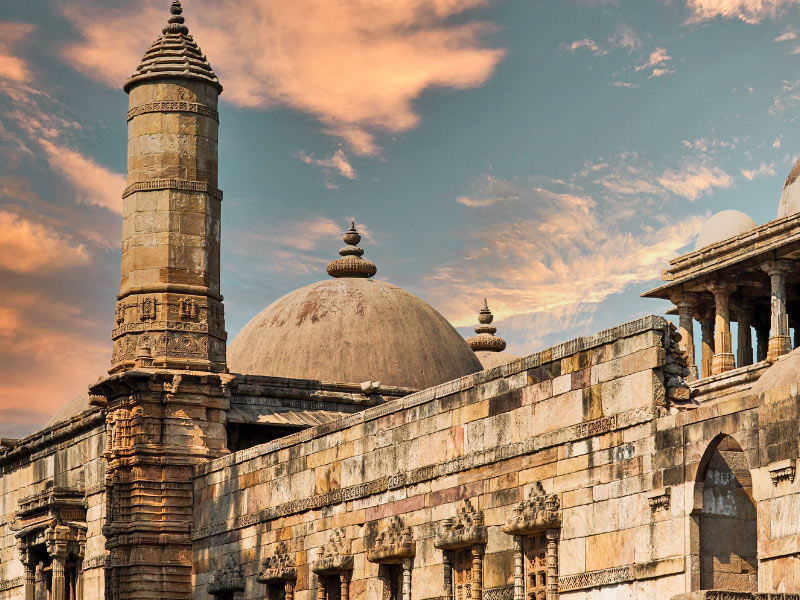
Vadodara
Vadodara- the city of Banyan (Vad) trees found in the city- speckled with gorgeous palaces, grand monuments and historical temples, the ancient city of Vadodara (earlier Baroda) renowned all over the world for the awe-inspiring Statue of Unity, the tallest of its kind in the world, that stands against a picturesque backdrop of Vindhya and Satpura mountains. UNESCO World Heritage Site of Champaner-Pavagadh Archaeological Park-a well-preserved Islamic pre Mughal city, remains one of the major attractions of the city.
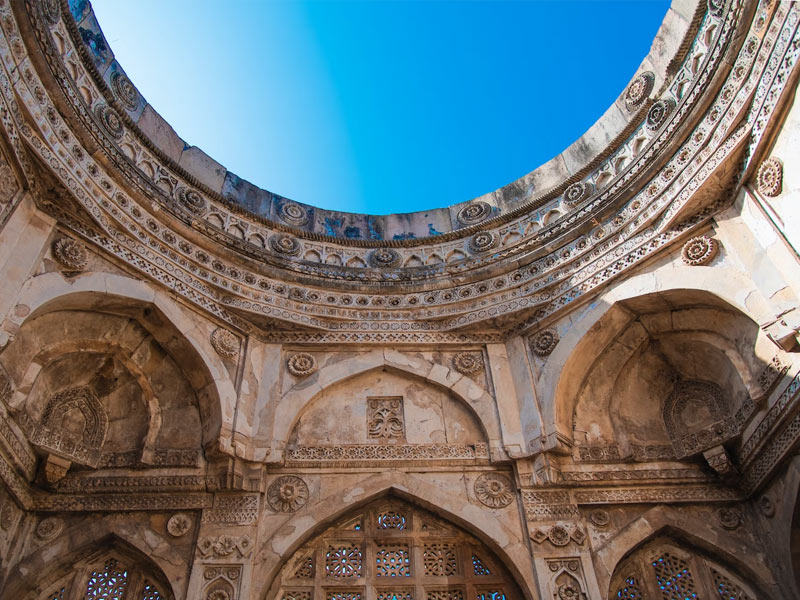
Champaner
Champaner is a historical city in the state of Gujarat, in western India. It is located in Panchmahal district, 47 kilometres from the city of Vadodara. The city was briefly the capital of the Sultanate of Gujarat.
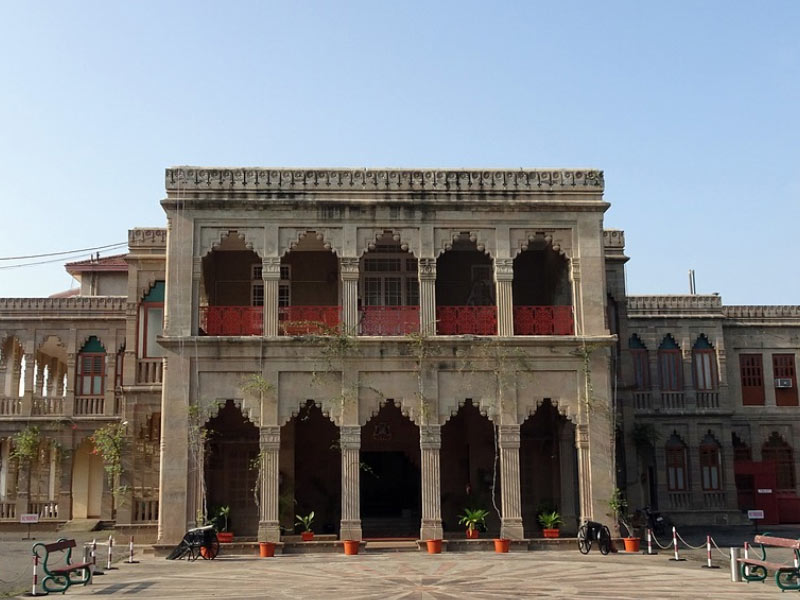
Bhavnagar
Bhavnagar is a city in the Bhavnagar district of the Saurashtra region of Gujarat, a state of India. It was founded in 1724 by Bhavsinhji Gohil. It was the capital of Bhavnagar State, which was a princely state before it was merged into the Indian Union in 1948.
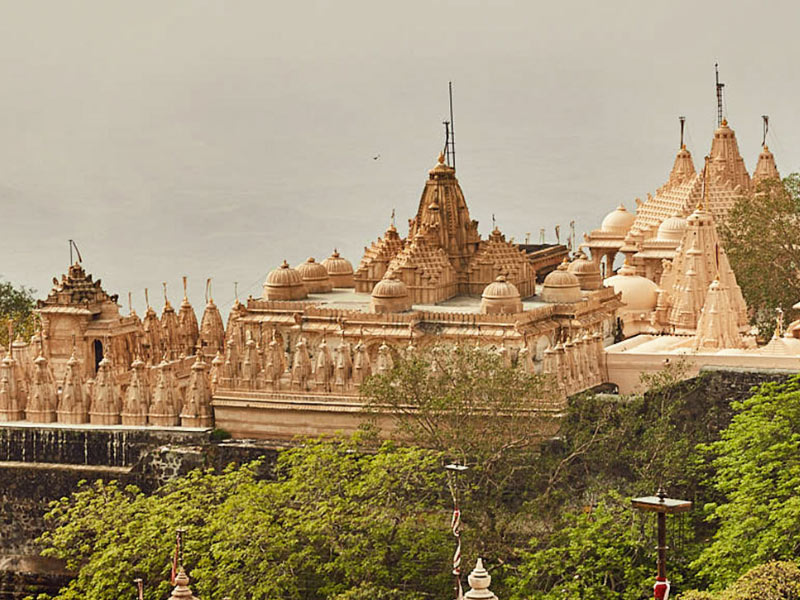
Palitana
Palitana is a major pilgrimage centre (tirtha) for Jains and the first vegetarian city in the world. Palitana is associated with Jain legends and history. Adinatha, the first of the Jain tirthankaras, is said to have meditated on the Shatrunjaya hill, where exquisitely carved in marble Palitana temples were later constructed.
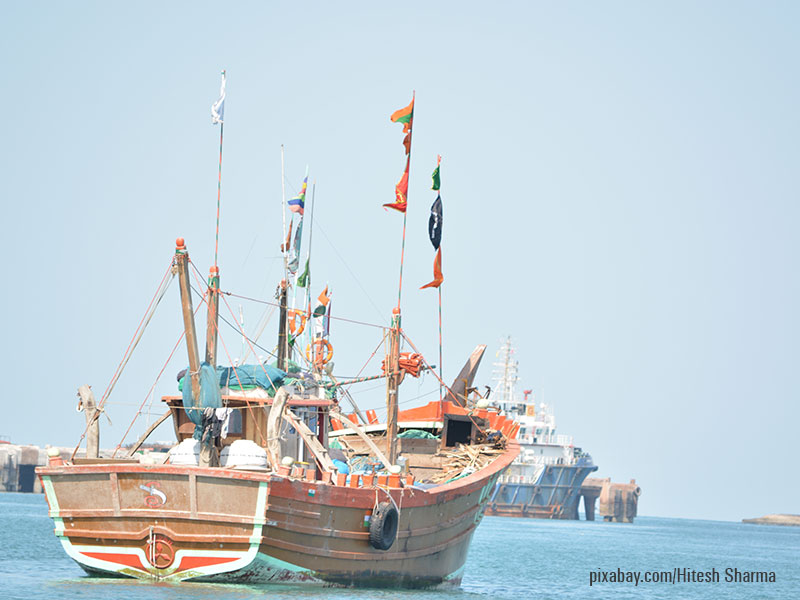
Diu
Diu is a tiny island in the Arabian Sea which is situated near the port of Veraval in Gujarat and is separated from the southern extremity of the Saurashtra peninsula by a narrow channel running through the swamp. Diu is a sensuous blend of sun, sand and deep blue sea. Diu is a coastal town at the eastern end of Diu Island, India. A bridge connects the island to the state of Gujarat. Overlooking the Arabian Sea, Diu Fort, a 16th-century Portuguese citadel, features a lighthouse and cannons. Inland, centuries-old St. Paul’s Church was built in elaborate baroque style. Nearby, whitewashed St. Thomas Church is now home to the Diu Museum, with wooden carvings and religious artifacts. The beach is exceptionally beautiful & quiet and is in the shape of a horse-shoe (semi circular). Overnight at hotel.
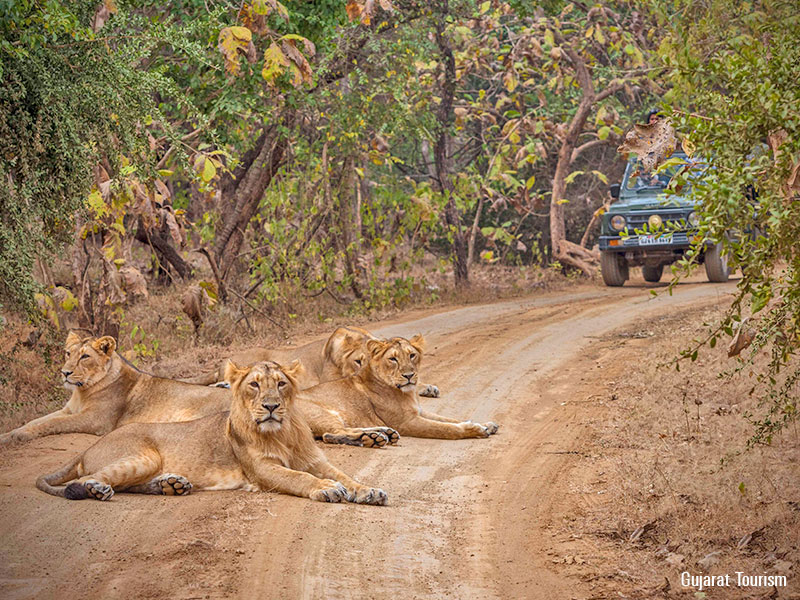
Sasan Gir
To find majestic Asian lions prowling around freely, Gir National Park is the only place in the world, besides the jungles of Africa. The entire forest of the park is dry and deciduous and is thus the ideal habitat for the Asiatic lion. Besides lions, leopards are the main attraction of the park. Other wildlife one can spot are sambar deer, chowsingha (the world’s only four-horned antelope), jackal, India fox, hyena etc. Moreover, the park invites birdwatchers for its more than 200 species of avifauna.
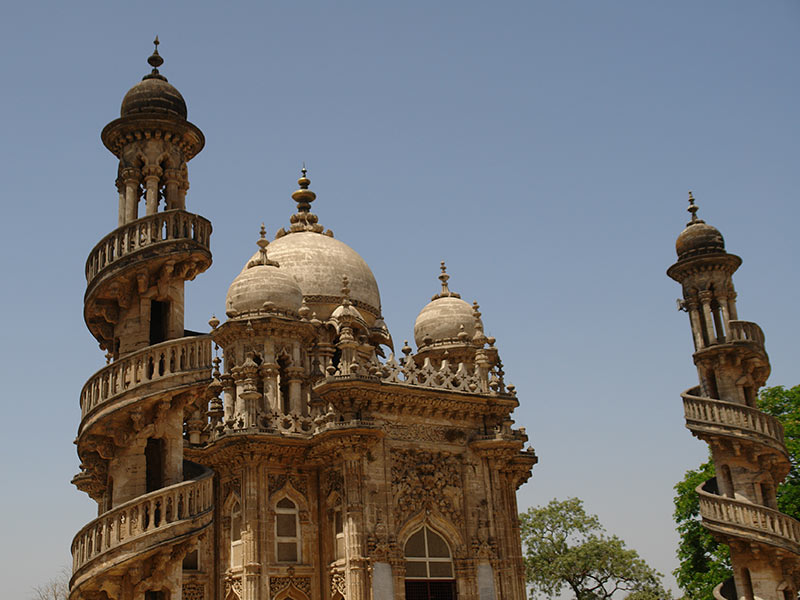
Junagadh
Junagadh is a city in the western Indian state of Gujarat. Mahabat Maqbara is the huge 19th-century mausoleum of a local ruler, which showcases intricate Indo-Islamic architectural details. Uparkot Fort, founded around 300 BC, has city views from its ramparts. Within the fort are the stone-cut stepwells Adi Kadi Vav and Navghan Kuwo, plus Buddhist caves. To the west, Darbar Hall Museum is housed in a former palace.
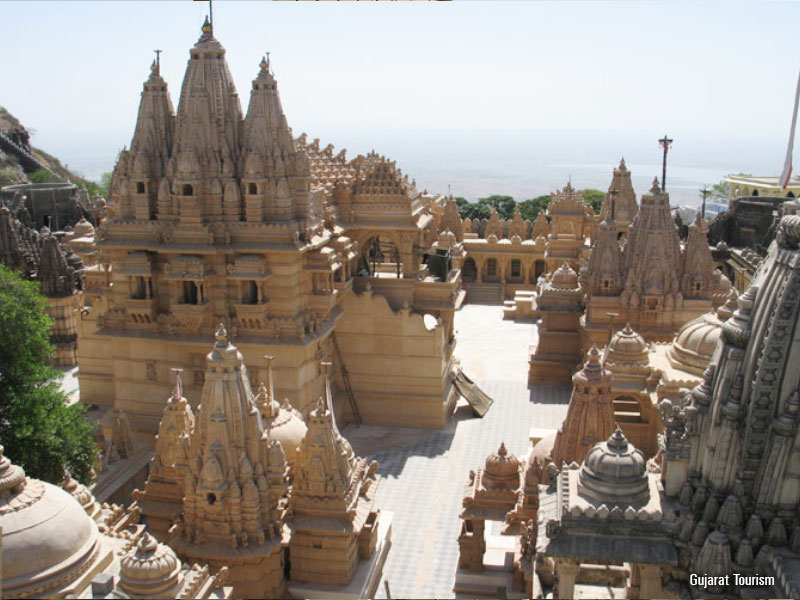
Rajkot
Rajkot - home to many freedom fighters, Rajkot carries significant influence in the Indian independence movement and today it is a bustling city that preserves its heritage in its monuments and ancient traditions of art and culture. A fine blend of modern and traditional values, Rajkot comes across as one of the liveliest cities of Gujarat.
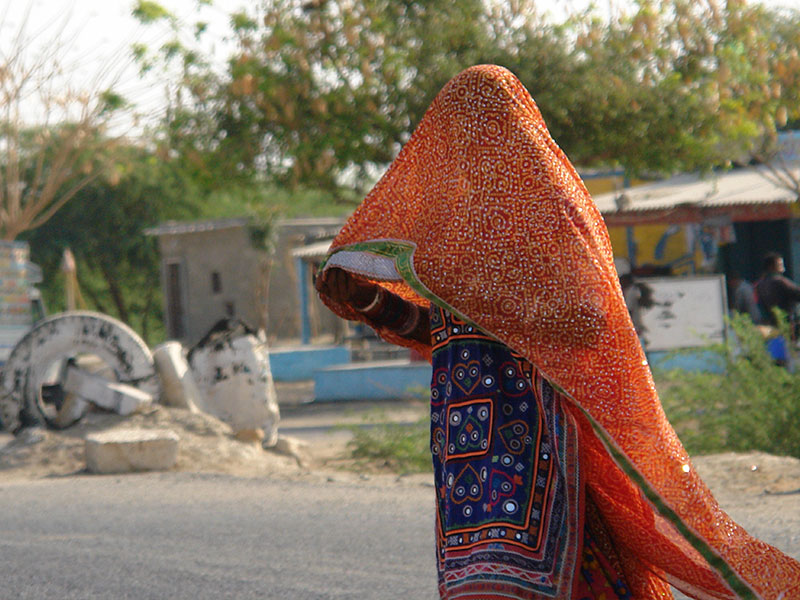
Bhuj
Bhuj is a city in the state of Gujarat, western India. It’s known for its centuries-old buildings, many of which were damaged in a 2001 earthquake. Close to Harmirsar Lake, the 18th-century Aina Mahal palace is elaborately decorated with chandeliers, mirrors and semi-precious stones. Nearby, the Italian Gothic–style Prag Mahal palace has a bell tower that overlooks the city, and a courtyard containing a Hindu temple. The historic city of Bhuj derives its name from the Bhujiyo Dungar, a hill, overlooking the present day Bhuj town. Bhuj is a typical example of a desert town located between two geographical features - Bhujiyo Dungar on the east & Hamirsar Lake on the west. Bhuj, the major town of Kutch, is an old city established in 1510. With its surrounding wall, the atmospheric bazaar area, crenelated gateways, old palaces and striking temples the town still retains a medieval character.
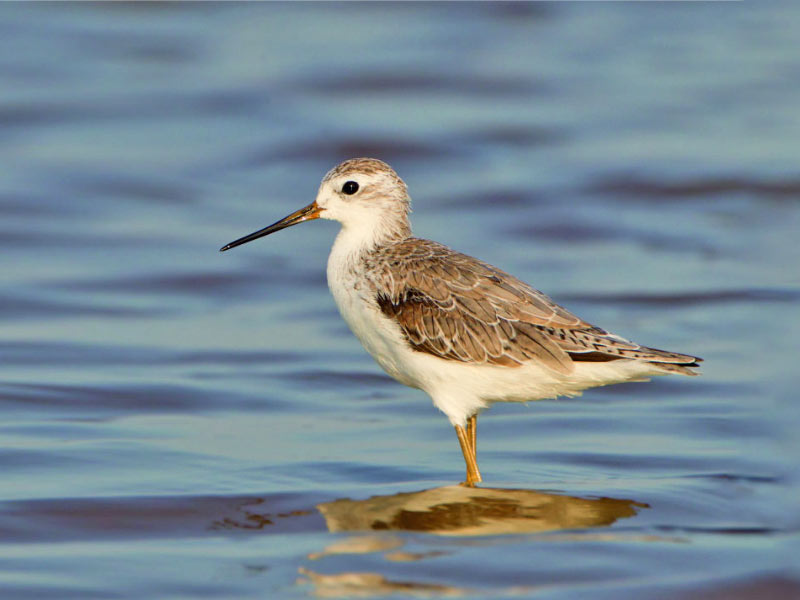
Dasada
Dasada is one of the 182 Legislative Assembly constituencies of Gujarat state in India. It is part of Surendranagar district and is reserved for candidates belonging to the Scheduled Castes.
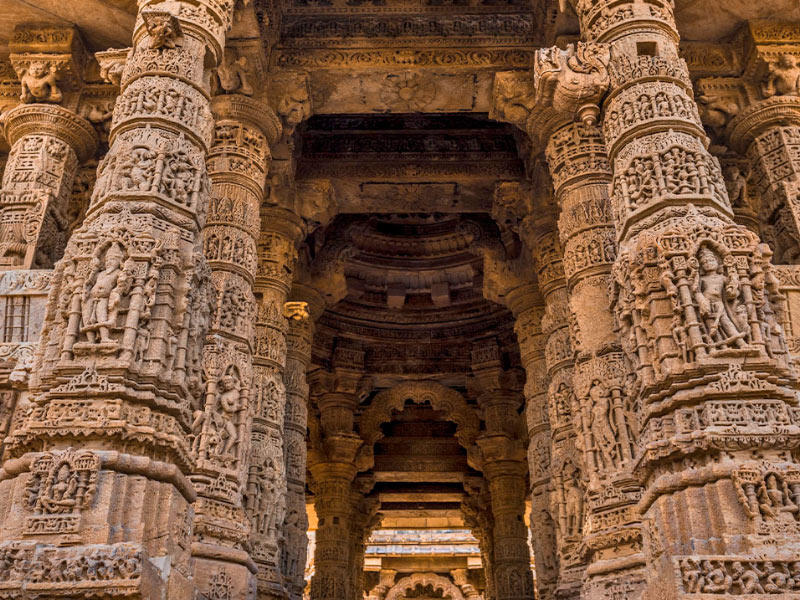
Modhera
A soothing drive amidst green farmlands just 25 km away from Mehsana on the way to the temples of goddess Bahucharaji reposes the village of Modhera. Set along the backdrop of River Pushpavati, surrounded by a terra-formed garden of flowering trees and songs of birds, rests the famed Sun temple of Modhera.
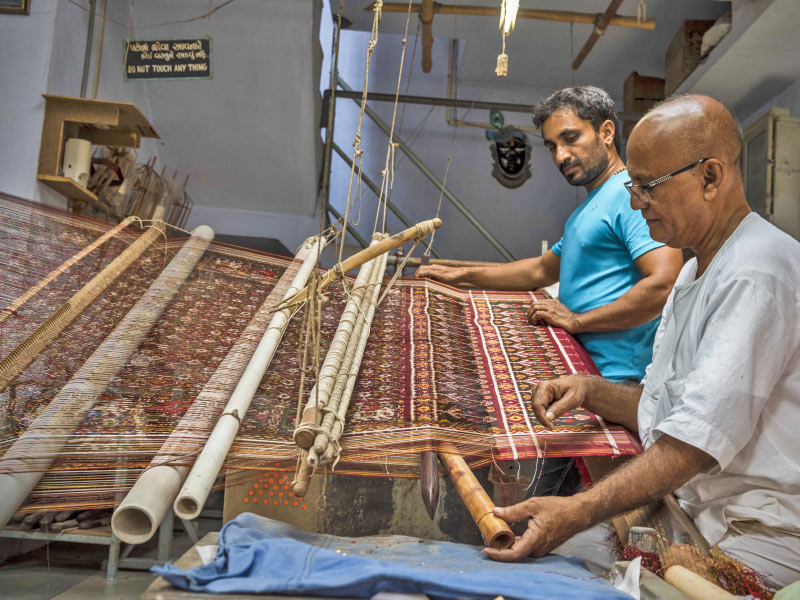
Patan
Patan Once the capital of Gujarat's Chalukya Dynasty in medieval times, the city has had an old history, with several Hindu and Muslim dynasties making it a thriving trading city and a regional capital of northern Gujarat. Known all around the world for the Rani ki vav (World Heritage Site) and the finest hand-woven patola sari, Patan has many unique attractions including forts, vavs (step wells), talavs (lakes) and places of worship.
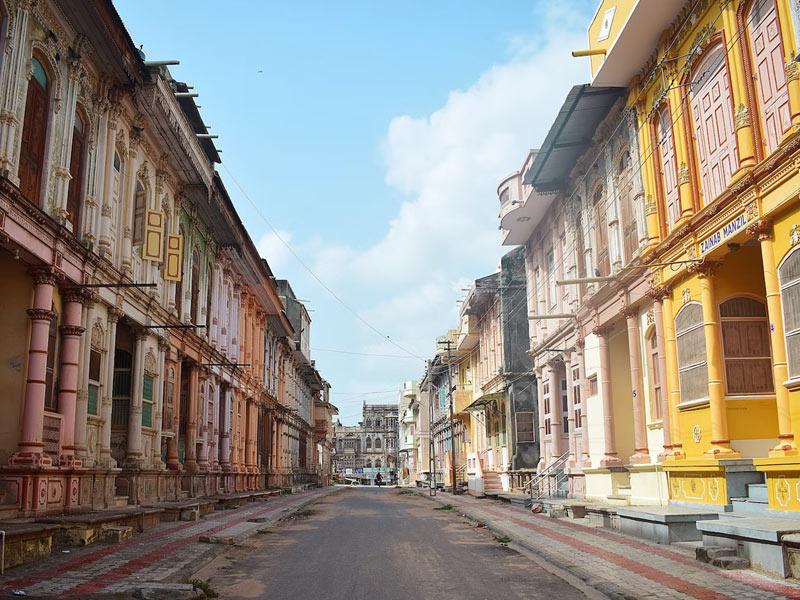
Siddhpur
Siddhpur, also spelled Sidhpur, is a town, municipality and headquarter of Sidhpur taluka in Patan district, in the Indian state of Gujarat. It is a historical place located on the bank of the endorheic Saraswati River, which is probably a remaining of the ancient Sarasvati River.
Spain / Ahmedabad
Departure from Spain with flight to Ahmedabad, with change of aircraft. Meals on board. Late night arrival in Ahmedabad. Transfer to the hotel. Overnight.
Ahmedabad
Media pensión. Morning at leisure for rest. In the afternoon walking tour of the old city: the Sarkhej Roza complex, the Great Mosque in the ancient Islamic bazaar (Jama Masjid). Dinner in hotel. Overnight.
Ahmedabad / Vadodara
Media pensión. In the morning, visit Mahatma Gandhi’s ashram where the famous “salt march” began and the Adalaj Vav palace well, one of the most beautiful stepwells in Gujarat. In the afternoon, departure for Baroda. Overnight.
Vadodara / Champaner / Vadodara
Media pensión. Departure for the ancient city of Champaner, a site now protected by UNESCO. A few mosques in exquisite Gujarati style bear witness to the only Islamic city dating back to the era before the advent of the Mughals. Lunch in historic residence. In the afternoon, visit the suggestive village of Sankera populated by ancient houses with refined wood inlays. Overnight.
Vadodara / Bhavnagar
Media pensión. In the morning, visit the imposing Laxmi Vilas Palace and the palace museum of Maharaja Fateh Singh. Afternoon drive to Bhavnagarh. Overnight.
Bhavnagar / Palitana / Bhavnagar
Media pensión. Full day excursion to Palitana, an important Jain pilgrimage destination with its eight hundred temples located on the sacred hill of Satrunjaya. Lunch at the small noble palace Vijay Vilas. Overnight.
Bhavnagar / Diu / Sasan Gir
Media pensión. Morning departure for Diu, once a Portuguese outpost in India. Sea Food Lunch. Visit of the island, a former Portuguese colony, an important port on the Arabian sea: the suggestive and mighty Portuguese Fort, the Church of San Paolo (still active), the Church of San Tommaso with its bizarre collection of European statues sixteenth century. Continuation in the late afternoon to the Sasan Gir National Park popular for Asiatic Lions. Overnight.
Sasan Gir / Junagadh / Rajkot
Media pensión. Morning game drive in the Gir National Park, home to the now extremely rare species of the Asiatic white lion. Departure for Junagarh. Visit the imposing fort that houses the ancient wells dug into the rock of Naughan and Adi Chadi; the Buddhist caves with the edict of Ashoka and the Mausoleum of Mahabat Maqbara. Continue to Rajkot. Overnight.
IMP: SasanGir National Park remain closed from 16th June till 15th Oct.
Rajkot / Bhuj
Media pensión. Transfer to Bhuj. In the afternoon, visit the Aina Mahal Museum and time available for walks in its bustling bazaar. Gujarati traditional dinner. Overnight.
Bhuj
Media pensión. In the morning, obtaining the entry permit to the Rann of kutch desert area, which here marks the border between India and Pakistan. Visit of the last tribal villages dedicated to precious handicraft activities such as the working with ancient methods of metal, lacquered wood and the finest embroidery on fabric. Sighting (in the period in which it forms) of the “white desert” towards the Pakistan border. Packed lunch. Overnight.
Bhuj / Dasada
Media pensión. Transfer to Dasada. In the afternoon, excursion by jeep in the spectacular salt desert of the little Rann of Kutch, where the last specimens of wild ass live and, in some periods of the year, a paradise for many species of large migratory birds. Overnight.
Dasada / Modhera / Patan / Sidhpur / Ahmedabad
Media pensión. In the morning departure for Modhera where the Temple of the Sun is located, dating back to 1026, one of the most interesting examples of Hindu architecture. It was designed so that the sun’s rays could pass through the arcades and bathe the whole building in light. Continuation to Patan with its magnificent well palace and finally with a short stop in Sidhpur, famous for the ancient houses of Muslim merchants. Room available until departure (in case of departure in the morning of the 13th, the room is still reserved for the whole night). In the evening, transfer to the airport. Boarding.
Ahmedabad / Spain
In the very early hours of the morning (night between the penultimate and last day) departure for the airport of origin. Arrival at destination and end of our services.
The Journey in brief
| Duration: | 13 Days and 12 Nights |
| Hotel: | Superior formula |
| Type: | Group Fixed Departure / Individual Private Tour |
| Departures: | Every Saturday (01st April 2023 - 23rd September 2023) |
| Guides: | Tour Escort Spanish Speaking |
| Meals: | Half board |
| The itinerary can also be created on an individual private basis with departures on free dates | |
Highlight of The Tour
- Guaranteed departures for a minimum of 4 people
- Q select: maximum 16 participants (All Spanish Speaking)
- Visit to the ancient city of Champaner, today a UNESCO site
- Lunch in a historic residence in Champaner
- Climb the sacred Palitana hill, Jain shrine with 800 temples
- Lunch in a small noble palace in Palitana
- Fish based lunch in Diu
- Visit to two Parks and two deserts
- Gujarati Thali dinner in Bhuj
Currency adjustment blocked upon travel confirmation
Lemon Tree Premier The Atrium
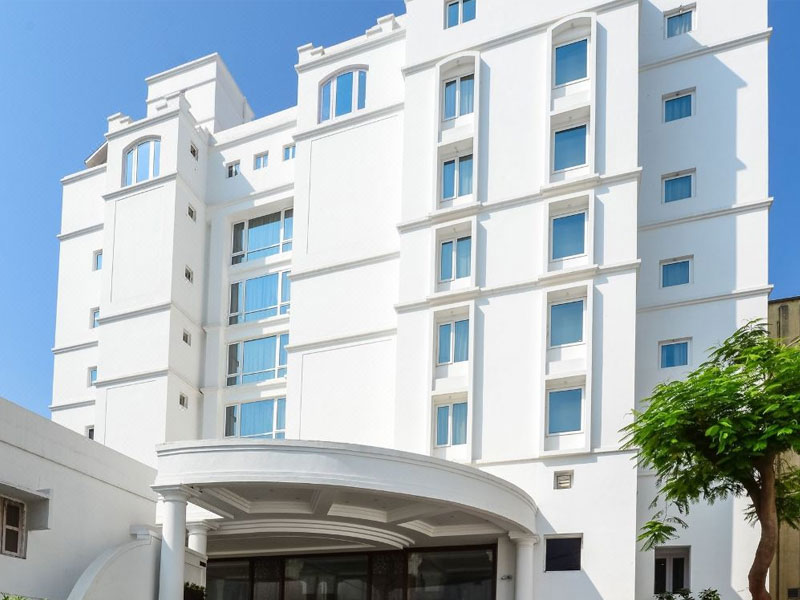
Lemon Tree Premier The Atrium
On the bank of Sabarmati, overlooking the riverfront, lounges this plush and stylish hotel, enhanced by landscaped greens and a serene water body. The hotel is designed to attract the millennium traveler with its 63 spacious and well appointed rooms and suites, a 24x7 multi-cuisine coffee shop– Citrus Café, with an interactive kitchen, and The Riverfront Grill, a picturesque alfresco grill and barbeque restaurant, which directly overlooks the Sabarmati river; besides a fully equipped gym and the largest indoor swimming pool in the city.
Fortune Landmark
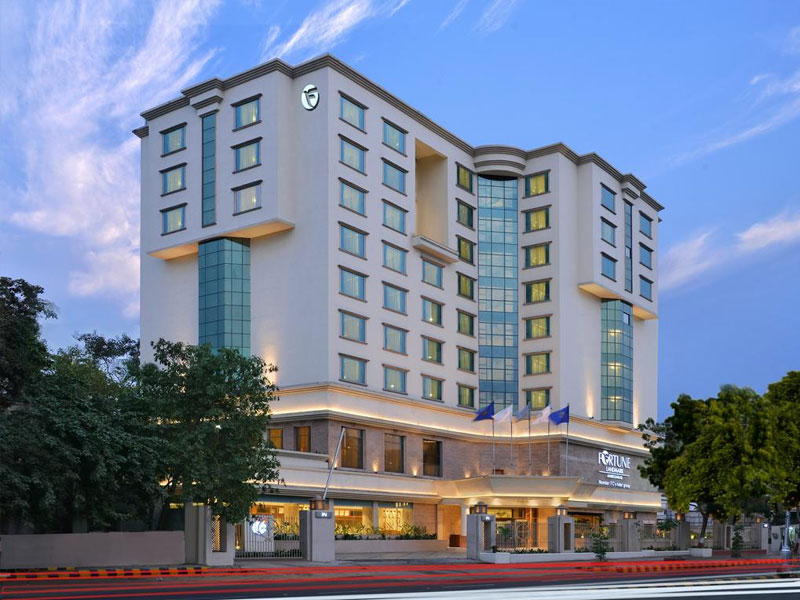
Fortune Landmark
Conveniently located in the heart of the city, Fortune Landmark is an upscale, contemporary business hotel in Ahmedabad. The hotel offers first class services and facilities, combining comfort of home with Fortune Hotels’ efficient service. Fortune Landmark, Ahmedabad offers a selection of 95 well-appointed rooms, including 64 Standard Rooms, 22 Fortune Club Rooms, 8 Executive Suites and 1 Presidential Suite, that have a contemporary décor and are equipped with all modern amenities. This hotel offers the perfect atmosphere to relax and enjoy the warm hospitality of Fortune Hotels.
Fortune Landmark
Conveniently located in the heart of the city, Fortune Landmark is an upscale, contemporary business hotel in Ahmedabad. The hotel offers first class services and facilities, combining comfort of home with Fortune Hotels’ efficient service. Fortune Landmark, Ahmedabad offers a selection of 95 well-appointed rooms, including 64 Standard Rooms, 22 Fortune Club Rooms, 8 Executive Suites and 1 Presidential Suite, that have a contemporary décor and are equipped with all modern amenities. This hotel offers the perfect atmosphere to relax and enjoy the warm hospitality of Fortune Hotels.

Welcomhotel By ITC Hotels
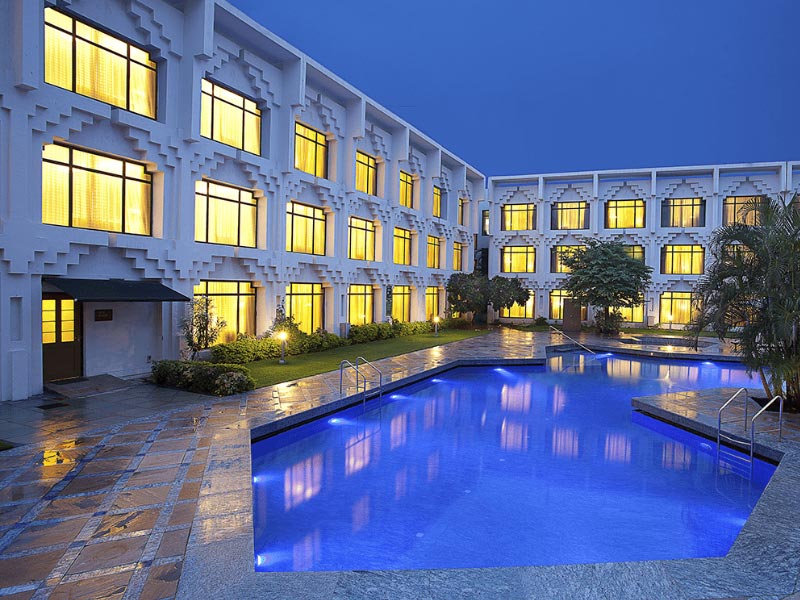
Welcomhotel By ITC Hotels
Inspired by the centuries old step wells of Gujarat, Welcomhotel Vadodara is built around its swimming pool, with its rippling waters reflecting the blue sky above. This hotel is located in the heart of the city’s business and entertainment district and is rightfully acknowledged as one the city’s leading hotels. It offers the finest standards of global hospitality, infused by the warmth of an Indian welcome.
Top3 Lords Resort Bhavnagar
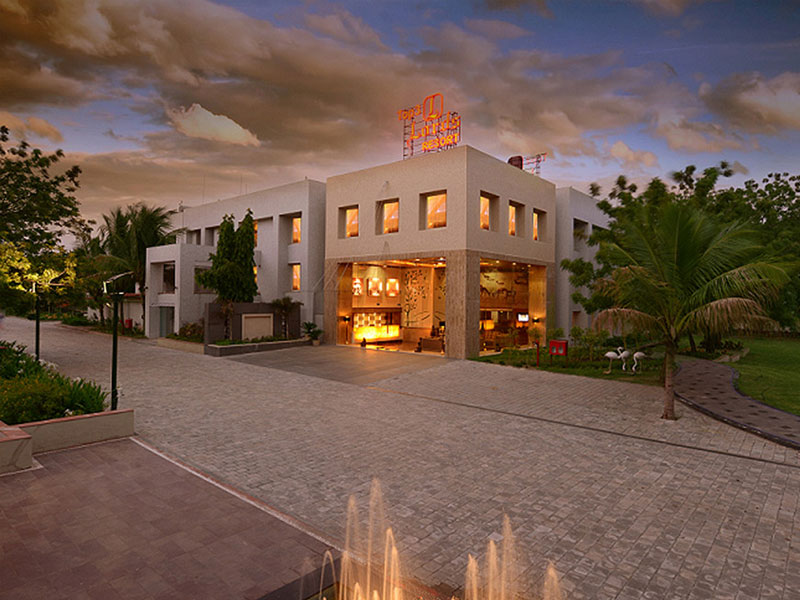
Top3 Lords Resort Bhavnagar
An elegantly designed property with top class service round the clock, has a 24/7 cafe serving hot beverages and snacks all day and night. Also on campus is a bespoke multi-cuisine restaurant named Blue Coriander serving delicious dishes to make every meal of yours a grand feast. You are sure to enjoy every bit of Lords Resort every minute of your stay.
Nilambag Palace
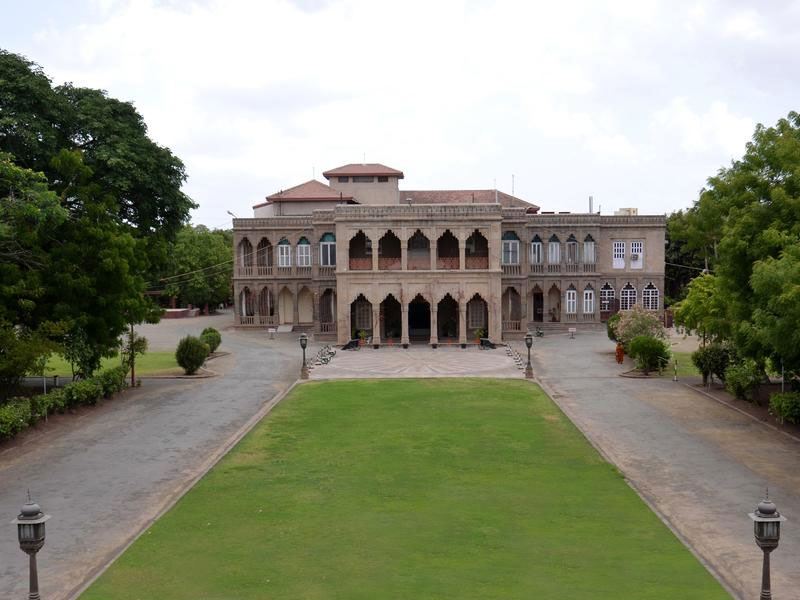
Nilambag Palace
The city of Bhavnagar is located in the Saurashtra Region of Gujarat. In the heart of this bustling urban city is the beautiful Nilambag Palace Hotel. In the year 1879, Maharaja Saheb Takhatsinhji of Bhavnagar commissioned the German architect, Simms to design the Nilambag Palace that for generations has remained the home of the erstwhile royal family of Bhavnagar. An imposing Rajula stone structure, the Palace was constructed with influences of Colonial architecture. Nilambag is a unique amalgamation of regal grandeur and functional magnificence. This glorious relic of the opulent times of Maharajas and Maharanis was home to the Gohil clan. When India became independent in 1947, Maharaja Krishna Kumar Singhji became the first Indian ruler to hand over his kingdom and join sovereign India. In the year 1984 the palace was converted into a heritage hotel, in order to maintain and also share a historic monument.
Nilambag Palace
The city of Bhavnagar is located in the Saurashtra Region of Gujarat. In the heart of this bustling urban city is the beautiful Nilambag Palace Hotel. In the year 1879, Maharaja Saheb Takhatsinhji of Bhavnagar commissioned the German architect, Simms to design the Nilambag Palace that for generations has remained the home of the erstwhile royal family of Bhavnagar. An imposing Rajula stone structure, the Palace was constructed with influences of Colonial architecture. Nilambag is a unique amalgamation of regal grandeur and functional magnificence. This glorious relic of the opulent times of Maharajas and Maharanis was home to the Gohil clan. When India became independent in 1947, Maharaja Krishna Kumar Singhji became the first Indian ruler to hand over his kingdom and join sovereign India. In the year 1984 the palace was converted into a heritage hotel, in order to maintain and also share a historic monument.

Lion Safari Camp
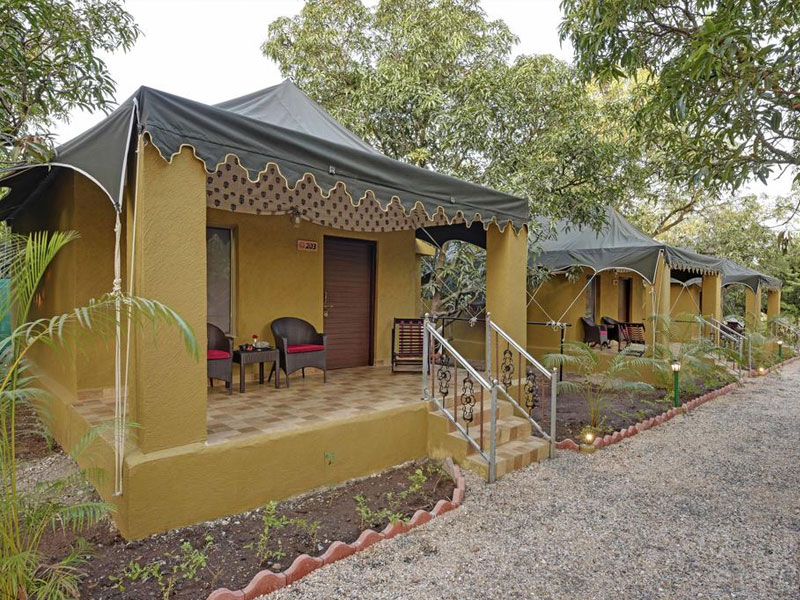
Lion Safari Camp
The LION SAFARI CAMP at Gir National Park A Luxury Wildlife Camp is owned and managed by Camps of India. It is located in a private mango orchard overlooking the Hiran River.The location presently has around 900 Mango Trees with only 2% of the entire land area being built so that the natural setting is maintained. This eco-friendly camp has 21 AC Luxury Tents each with large well furnished bedrooms and an attached en-suite bathrooms. All the tents are beautifully furnished with natural materials and open out to an extended deck - An ideal place to sit and relax amongst nature.
The Imperial Palace
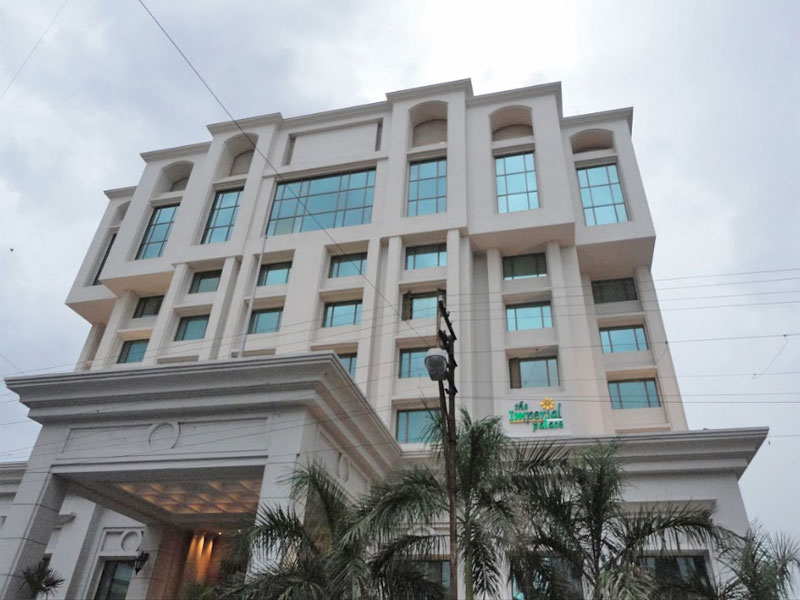
The Imperial Palace
The Imperial Palace hotel Rajkot is a masterpiece of simplicity, comfort and elegance, offering the ultimate in luxury, with the most spacious rooms among Rajkot hotels. Each one of the hotel's opulent guest rooms is comfortable, stylish and equipped with advanced technology for the convenience of hotel guests - underlined, of course, by the extremely professional and sincere service by the Imperial staff which makes it stand out from other Rajkot hotels. Housing all facilities including a business centre, beauty parlor, health club, gym, saloon, boutique, internet cafe, pastry shop, travel desk & money exchange, the Imperial Palace hotel gives you full value for your money. Business travelers and pleasure seekers both are drawn back to the Imperial Palace Hotel experience time and time again.
Kutch Safari Lodge
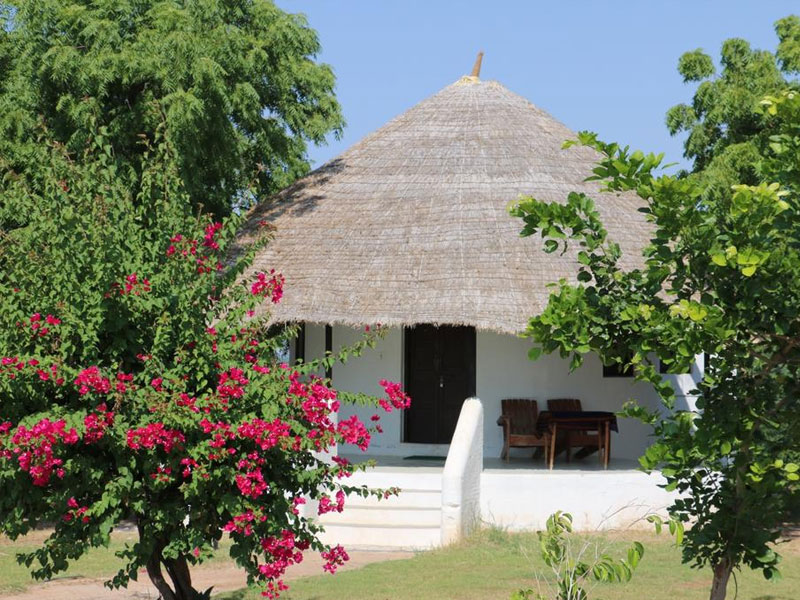
Kutch Safari Lodge
On the outskirts of Bhuj, in the Rann of Kutch lies The Kutch Safari Lodge, it is an ideal home base, for excursions into the deeper landscape of the white desert, and to experience the unique lifestyle and beautiful traditional Banni Villages known for their handicrafts. Kutch Safari Lodge transports you into a different home away from home. The resort is located 14 km from Bhuj on the Khavada road, by the Rudramata Dam. It has a serene view overlooking the large water body and a giving a chance to connect with nature.
Rann Riders
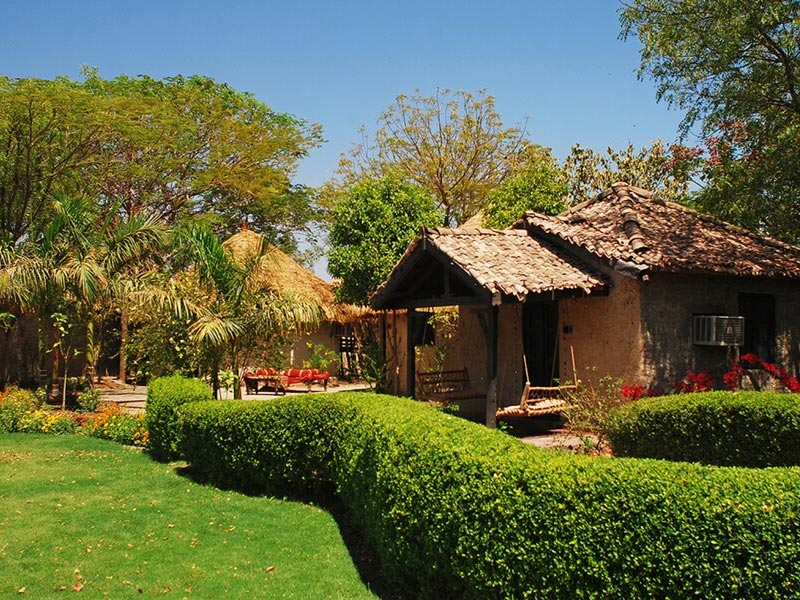
Rann Riders
Rann Riders is an enchantingly ethnic destination resort, set among wetlands and agricultural fields. The resort has imaginatively designed cottages that blend with the surrounding countryside. Located near Dasada village, it serves as an ideal base to explore the famed culture, weaves and handicrafts of the Surendranagar district. Rann Riders offers jeep, horse and camel safaris in the Little Rann of Kutch, habitat of Asiatic Wild Ass and a birdwatching paradise.
Lemon Tree Premier The Atrium

Lemon Tree Premier The Atrium
On the bank of Sabarmati, overlooking the riverfront, lounges this plush and stylish hotel, enhanced by landscaped greens and a serene water body. The hotel is designed to attract the millennium traveler with its 63 spacious and well appointed rooms and suites, a 24x7 multi-cuisine coffee shop– Citrus Café, with an interactive kitchen, and The Riverfront Grill, a picturesque alfresco grill and barbeque restaurant, which directly overlooks the Sabarmati river; besides a fully equipped gym and the largest indoor swimming pool in the city.
Fortune Landmark

Fortune Landmark
Conveniently located in the heart of the city, Fortune Landmark is an upscale, contemporary business hotel in Ahmedabad. The hotel offers first class services and facilities, combining comfort of home with Fortune Hotels’ efficient service. Fortune Landmark, Ahmedabad offers a selection of 95 well-appointed rooms, including 64 Standard Rooms, 22 Fortune Club Rooms, 8 Executive Suites and 1 Presidential Suite, that have a contemporary décor and are equipped with all modern amenities. This hotel offers the perfect atmosphere to relax and enjoy the warm hospitality of Fortune Hotels.
Fortune Landmark
Conveniently located in the heart of the city, Fortune Landmark is an upscale, contemporary business hotel in Ahmedabad. The hotel offers first class services and facilities, combining comfort of home with Fortune Hotels’ efficient service. Fortune Landmark, Ahmedabad offers a selection of 95 well-appointed rooms, including 64 Standard Rooms, 22 Fortune Club Rooms, 8 Executive Suites and 1 Presidential Suite, that have a contemporary décor and are equipped with all modern amenities. This hotel offers the perfect atmosphere to relax and enjoy the warm hospitality of Fortune Hotels.

India
Journey to India.......once is not enough!!!!
BANKING AND CURRENCY
Currency
The Indian Rupee is the official currency of the Republic of India. The modern Indian Rupee is subdivided into 100 paise (singular paisa). Banknotes in circulation come in denominations of INR 5, 10, 20, 50, 100, 500 and 2000. Please note that as of November 2016, the older 500 and 1000 INR note are no longer valid legal tender and only new ₹500 notes will be accepted.
The latest Indian Rupee coins are available in denominations of INR 1, 2, 5, 10.
The import and export of local currency is prohibited. The import of foreign currency is unlimited. However, amounts exceeding US$5,000 or equivalent in cash, or US$10,000 or equivalent in all forms of currency must be declared. The export of foreign currency is allowed up to the amount imported and declared.
Currency can be changed at banks, airports or authorised money changers. Many hotels also have facilities to change money but this is a more expensive option. It is illegal to exchange money through unauthorised money changers. US Dollars and Pounds Sterling are the easiest currencies to exchange.
Banking
Banking hours: Monday-Saturday 10h00-03h30 (Bank will be closed on second and forth Saturday).
Strictly speaking, you can neither import nor export Indian currency, but you can get some at the airport straight away to at least get you transport to your accommodation. There are Authorized Foreign Exchange dealers in most big cities, and banks will also change your currency at a fair rate if you have time for the paperwork.
A good way of getting your travellers currency is via an ATM but beware of hidden bank charges, both from the bank providing the ATM and the card-issuing bank - you also do not know what exchange rate you are getting.ATMs are found in most towns and are recommended for cash withdrawals.
Visa, MasterCard and American Express are usually accepted in tourist hotels and many other shops. Debit cards are also widely accepted.
Travellers cheques are widely accepted and may be changed at banks and larger hotels. The most widely accepted currencies include US Dollars and Pounds Sterling. Some banks may refuse to change certain brands of traveller's cheques whilst others may exchange quite happily.
TRAVEL, TRANSPORT AND GETTING AROUND
India is big and there are lots of interesting ways to travel around it, most of which could not very well be described as efficient or punctual. Allow considerable buffer time for any journey with a fixed deadline (eg. your flight back), and try to remember that getting there should be half the fun.
India's large size and uncertain roads make flying a viable option, especially as prices have tumbled in the last few years. Even India's offshore islands and remote mountain states are served by flights, the main exceptions being Sikkim and Arunachal Pradesh (although crossing over from neighbouring states is fairly easy). Due to the aviation boom over the last few years, airports have not been able to keep up with the air traffic. Most Indian airports continue to function with one runway and a handful of boarding gates. Check in and security queues can be terribly long, especially in Delhi and Mumbai.
Railways were introduced in India in 1853, more than one and half a centuries ago, by the British, and today India boasts of the biggest network of railway lines in the world, and the rail system is very efficient, if not always on schedule. Travelling on Indian Railways gives you the opportunity to discover the Indian landscape and scenic beauty first hand and is generally more economical than flying domestic. It is one of the safest ways of travel in India. With classes ranging from luxurious to regular, it's the best way to get to know the country and its people. Most train passengers will be curious about you and happy to pass the time with a chat.
In central locations of big cities like airports or stations reliable pre-paid taxis are available and will save you money as well as the bargaining hassle. However beware of touts who would claim themselves to be running pre-paid taxis. Always collect the receipt from the counter first. The receipt has two parts - one part is for your reference and the other part you will need to handover to the taxi driver only after you reach your desired destination. The taxi driver will get his payment by submitting or producing this other part to the pre-paid taxi counter. Normal taxis running by meter are usually more common. In many non Metro Cities (or even in Metros depending on time) taxies or autos may ply without the usual meter.
While you can't take a cross-country bus-ride across India, buses are the second most popular way of travelling across states and the only cheap way of reaching many places not on the rail network (eg. Dharamsala).
FOOD, DRINK AND CUISINE ADVICE
Water for drinking, brushing teeth or making ice should first be boiled or otherwise sterilised. Milk is often unpasteurised and should be boiled. Avoid dairy products likely to have been made from non-boiled milk. Only eat well-cooked meat and fish. Do not eat salads, vegetables should be cooked and peel your own fruit. Don’t eat street vendor food unless it is piping hot. Tap water is not safe to drink, rely on bottled water which is widely available. However, do check the seal on bottled water.
Indian food is world-renowned for its tantalising flavours, spiciness and enormous variety. Curries are created from the subtle and delicate blending of spices such as cumin, turmeric, cardamom, ginger, coriander, nutmeg and poppy seed although these vary from region to region and every spice has medicinal properties and use.
Vegetable dishes are more common than in Europe, particularly in the fruity, coconutty dishes of southern India, while northern India has an entirely different but equally satisfying cuisine to sample. Breads like paranthas, chapatis, naans and rotis are also part of the main diet in several states like Punjab, Haryana and Uttar Pradesh. Achars (pickles), relishes and chutneys again vary by region and add more resonance to amazing meals.
Sweets or mithai too have regional specialities. They tend to be milk based and some are syrupy and fried. Well-known northern sweets are gulab jamun, jalebi (it’s worth watching how these syprup-based confections are made in the street), kulfi, kheer, halwa and laddu. From the east are rasgulla and rasmalai. The south has several burfi and halwa-type desserts like coconut burfi and badam halwa made from almonds.
While care should be taken in where one eats, exceptional food can be had in the most humble surroundings such as food at ashrams as can be found in 5-star restaurants. Non-vegetarians will find fabulously spiced mutton dishes according to regional specialities including fish dishes typical to coastal areas.
10 to 15% is usual in restaurants that impose no service fee; optional where service fee is added to bill.
CLIMATE AND WEATHER
The weather is mainly hot most of the year with significant variations from region to region. The coolest weather lasts from around the end of November to the beginning of March, with fresh mornings and evenings, and mostly sunny days. The really hot weather, when it is dry, dusty and unpleasant, is between March and June. Monsoon rains occur in most regions in summer anywhere between June and early October.
CLOTHING AND DRESS RECOMMENDATIONS
Male or female, one rule covers all visitors to India: don't leave the house with your arms or legs bare. You'll naturally get attention as a foreigner, as full-on staring is common and accepted on Indian streets, but you'll suffer far less negative attention if you remain covered up. For most locations and seasons in India, thin, loose linen or cotton pants and button-down shirts will keep you comfortable in hot, humid weather and help you blend in. While you may see Indian young adults sporting tight jeans and fitted brand-name tops, you'd stand out significantly more in the same outfit. If you visit anywhere in northern India - not just the mountains, Delhi too - during the winter, prepare for seriously cold weather. Bring jeans and heavy shirts and pick up an Indian wool wrap.
What you can get away with at an Indian beach depends entirely on which beach you visit. In the state of Goa, a popular beach and club getaway destination, locals are accustomed to seeing tourists in bikinis on the beach and Indian men often sport Speedos. But skimpy clothes need to stay on the beach. Don't walk around town or your hotel in nothing but a bikini and sarong. In less Western-frequented beach destinations, such as the beaches around Bombay, Alibag and Chowpatty, or anywhere in the south, hit the beach in light pants and a tunic.
When visiting temples and other religious sites on your own or part of a tour, be on the lookout for signs advising visitors to dress in a specific way to enter the temple. The government of India advises that some religious institutions require visitors to cover their heads or remove their shoes, and covering your legs and arms in respect goes without saying. Certain sites may carry more specific requirements, such as donning a certain colored sash or sarong-like covering. Take your cue from other visitors exiting the site.
ELECTRICITY AND PLUG STANDARDS
For the most part, electrical sockets (outlets) in India are the "Type D" 5 amp BS-546 sockets. This is actually an old British standard. The "Type D" Indian plug and socket is not to be confused with the "Type M" South African plug and socket. In pictures, they look very similar, but the South African type is much larger than the Indian type, and they are physically incompatible. If your appliance's plug doesn't match the shape of these sockets, you will need a travel plug adapter in order to plug in.
Electrical sockets (outlets) in India usually supply electricity at between 220 and 240 volts AC. If you're plugging in an appliance that was built for 220-240 volt electrical input, or an appliance that is compatible with multiple voltages, then an adapter is all you need. If your appliances are not compatible with 220-240 volt electrical output, a voltage converter will be necessary.